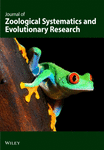Speciation within the plumosus group of the genus Chironomus Meigen (Diptera, Chironomidae)
Abstract
The phylogenetic relationship between C. plumosus, C. balatonicus, C. muratensis, C. nudiventris and C. vancouveri has been investigated by means of cytological analysis of individuals from different populations and of hybrids which were obtained after artificially induced copulation in the laboratory. It is suggested that all these species originate from a common hypothetical ancestor with chromosome structure corresponding to the standard banding pattern of the polytene chromosomes of C. plumosus. In a process of allopatric speciation on one side of the Bering Sea in the species C. vancouveri has been formed. On the Eurasian side of the Bering Sea C. plumosus is characterized by the standard arrangements and a dine in chromosome variability. The conversion of the standard karyotype through heterozgygous polymorphism into another homozygous karyotype can be recognized. From a homokaryotic ancestor the species C. balatonicus, C. muratensis and C. nudiventris must have arisen by sympatric speciation.
The phylogenetic relationships are deduced from the complex chromosomal patterns and from genic differences. Physiological reproductive incompatibility has been observed between C. plumosus and C. balatonicus.
Zusammenfassung
Artbildung innerhalb der plumosus-Gruppe der Gattung Chironomus (Diptera, Chironomidae)
Mit Hilfe von zycologischen Analysen an Individuen aus verschiedenen Populationen and deren Hybriden, die durch künstlich induzierte Kopulationen im Labor gewonnen worden waren, konnten die phylogenetischen Verwandtschaftsbeziehungen zwischen C. plumosus, C. balatonicus, C. muratensis, C. nudiventris und C. vancouvery untersucht werden. Es wird angenommen, daß alle diese Arten aus einer gemeinsamen hypothetischen Ausgangsart hervorgegangen sind, die in den Riesenchromosomen das Standard-Chromosomenmuster von C. plumosus besaß. Durch einen allopatrischen Artbildungsprozeß entstand dann C. vancouveri auf der der einen Seite der Beringstraße. Auf der eurasiatischen Seite der Beringstrße a hingegen ist C. plumosus charakterisiert durch den Besitz des Standard-Chromosomenmusters and durch eine klinale Chromosomenvariabilität. Es läßt sich auch eine Umwandlung des Standard-Karyotypes über einen heterozygoten Inversionspolymorphismus in einen anderen homozygoten Karyotyp erkennen. Die Arten C. balatonicus, C. muratensis and C. nudiventris müssen in einem sympatrischen Artbildungsprozeß aus einem homokaryotypischen Vorfahren entstanden sein.
Die phylogenetischen Beziehungen werden aus dem komplexen Chromosomenmuster und aus genetischen Unterschieden abgeleitet. Eine reproduktive, physiologische Inkompatibilität wurde zwischen C. plumosus und C. balatonicus beobachtet.




